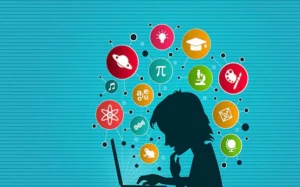GS2 – Governance

Context:
Kerala has become the first state in India to achieve total digital literacy, marking a significant milestone in the country’s digital empowerment journey.
What is Digital Literacy?
- Digital Literacy refers to the ability of individuals and communities to effectively understand, access, and use digital technologies in everyday life.
- It includes fundamental skills like:
- Using smartphones and computers
- Navigating the internet and apps
- Sending emails
- Understanding digital safety, privacy, and online etiquette
Digitally Literate Household:
A household is considered digitally literate if at least one person aged 5 or above can operate a computer and use the internet.
Main Objective:
To equip individuals with basic ICT (Information and Communication Technology) skills, enabling them to:
- Actively participate in democratic processes
- Improve livelihood opportunities
- Engage with digital governance and services
Current Status in India
- Overall Digital Literacy: ~38% of Indian households
- Urban Areas: ~61% digital literacy
- Rural Areas: Only about 25%
During the pandemic, sectors like education, healthcare, and finance saw rapid digital transformation, increasing the need for digital literacy across the country.
Why Digital Literacy Matters
- Economic Empowerment: Enables access to jobs, online markets, and government welfare schemes.
- Bridging Gender Divide: Empowers women by increasing digital access, especially in rural areas.
- Boosts Digital Economy: Fosters innovation, entrepreneurship, and skilled workforce participation.
- Strengthens Democracy: Helps citizens engage with governance, demand accountability, and make informed decisions.
- Enhances Online Safety: Helps users recognize scams, cyberbullying, and take precautions online.
- Promotes Good Governance: Reduces dependence on intermediaries and improves transparency in public services.
- Supports Knowledge Economy Goals: Encourages mass participation in digital platforms and information-based economies.
Challenges to Achieving Universal Digital Literacy
- Technology Access Gaps: Lack of devices and internet connectivity in rural and underprivileged regions.
- Skills Shortage: Teachers and learners often lack proper training to use digital tools effectively.
- Foundational Illiteracy: Basic reading/writing skills are still missing in many parts of the population.
- Language Barriers: Predominance of English content makes it inaccessible to non-English speakers.
- Affordability Issues: High cost of devices and data remains a barrier for economically weaker groups.
- Digital Gender Divide: Socio-cultural factors restrict women’s access to digital technologies in many areas.
Major Government Initiatives
- Digital India Mission (2015):
Aims to transform India into a digitally empowered society and knowledge economy. - National Digital Literacy Mission (NDLM):
Seeks to digitally train at least one person per household across selected states/UTs. - PMGDISHA (Pradhan Mantri Gramin Digital Saksharta Abhiyan):
Targets to make 6 crore rural individuals digitally literate under MeitY. - DISHA (Digital Saksharta Abhiyan):
Collaborates with NGOs, private players, and academic bodies to promote digital literacy. - NDLI (National Digital Library of India):
Offers free access to e-books, journals, and educational content for learners. - SWAYAM & DIKSHA Platforms:
Provide online learning content for students and teachers to promote digital education. - SPIRIT Scheme:
Financial assistance to NGOs and institutions for setting up IT training centres in rural areas.




